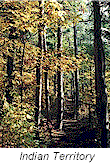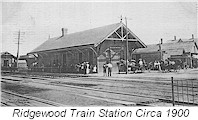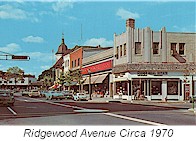|
History of Ridgewood
 The territory now known as Ridgewood was
once the hunting and fishing grounds of the Lenni Lenape Indians. When
the first European settlers arrived, they found a forested wilderness
abundant in turkeys and rattlesnakes. The territory now known as Ridgewood was
once the hunting and fishing grounds of the Lenni Lenape Indians. When
the first European settlers arrived, they found a forested wilderness
abundant in turkeys and rattlesnakes.
During Colonial times, the entire region
was known as Paramus. The first settlements were by the Dutch in
the area of the Old Paramus Reformed Church located at what is now the
intersection of East Glen Avenue and Route 17. Several times
during the Revolutionary War, this church served as the headquarters of
General George Washington.
At the end of the War, there were still
only about twenty families residing in the boundaries of modern-day
Ridgewood. The early Dutch Americans who inhabited this area were
self-reliant and spent their days tending to the necessities of
survival. Most lived off farming and some established mills along the
Hohokus Brook or Saddle River. Roads were few and far
between. Development was slow and most new homes were built for
the descendents of the original settlers.
For many years, the area was popularly known as Godwinville
in honor of Abraham Godwin, a local Revolutionary War hero. In
the 1860s it became known as Ridgewood and the name has remained. Today, a
statue of Abraham Godwin stands in Van Neste Park as a tribute to the Village's
early namesake.
 The railroad arrived in 1848 and times
changed forever. In the beginning, the nearest stop was in Hohokus.
However, mill owners clamored for a closer one and in 1851 a stop was created
near the present-day train station. A second track was added in 1865 and
two more in 1902-03. The railroad arrived in 1848 and times
changed forever. In the beginning, the nearest stop was in Hohokus.
However, mill owners clamored for a closer one and in 1851 a stop was created
near the present-day train station. A second track was added in 1865 and
two more in 1902-03.
The train set off a modest real estate boom as
New Yorkers were attracted to the agreeable residences that were being built
within easy distance of the station. The number of houses grew from
59 in 1851 to 1,200 in 1876. Businesses were established to service the
increasing population.
By 1900, the population of Ridgewood had reached
nearly 2,700. Residents were drawn to the clean air, broad
tree-lined thoroughfares and numerous parks and recreational facilities. Many
depended on the convenient train commute to New York City. The Village had
also developed a reputation for families, education and pride of ownership.
 Rapid population growth at the turn of the
century fueled the development of a diverse central business district. By
1930, the population had reached 12,188 and the downtown commercial center had
begun to encroach on neighboring residential zones. By 1972, Ridgewood's
population was over 27,500 and the mature downtown area was fully developed
within its present boundaries. Rapid population growth at the turn of the
century fueled the development of a diverse central business district. By
1930, the population had reached 12,188 and the downtown commercial center had
begun to encroach on neighboring residential zones. By 1972, Ridgewood's
population was over 27,500 and the mature downtown area was fully developed
within its present boundaries.
Today, Ridgewood is the pride of New Jersey
with its vintage homes and "main street" appeal. The
restaurants and shops of a dynamic downtown attract visitors from all over the
region. Commuting proximity to New York continues to service those who rely on
the big city for their livelihood yet yearn for the peace and values of a
close-knit bedroom community. First-class schools and commitment to family
encourage children to become caring and contributing members of society.
Shade trees, soccer fields and sidewalk sales - Ridgewood offers it all, with an
appreciation for the past and optimism for the future.
| Sources: |
Celebrating
a Centennial: A History of Ridgewood, New Jersey.
Ridgewood Centennial Celebration Committee, 1994. |
|
Parrillo,
Vincent, Beth Parrillo and Arthur Wrubel. Images of America:
Ridgewood. Charleston: Arcadia Publishing, 1999. |
|